


many of which have be seen from our very own pool deck!
Most of their time is spent sleeping in their burrows. The time they do spend above ground is spent rooting and sniffing around for earthworms and grubs to dig up and eat using use their long tongue, like an anteater, to lick up any food they find.
Most armadillos grow to about 14 pounds and don't bite as they only have teeny mouths with small peglike teeth. We have a local resident (pictured) that lives in a burrow underneath our neighbour's in ground spa.
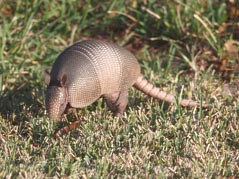
Most adult raccoons weigh between 12-20 pounds and walk on all fours with a highly arched back, yes, just like in the cartoons. They have adapted well to urban areas, with some even having lost their fear of people, sometimes standing their ground when approached. They are often seen coming out of the clearing to the back of our home and regularly walk along side the pool screen.
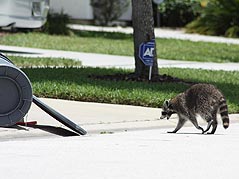
Possums are nocturnal animals that grow up to be around 2-3 feet long and 8-14 pounds (about the size of a house cat) and have small naked ears, long naked and scaly tails and a long pointed muzzle They are omnivorous preferring meat to vegetables but will eat almost anything, including insects, snails, fruit, small rodents, eggs, berries, grasses, leaves, carrion, pet food, and garbage.
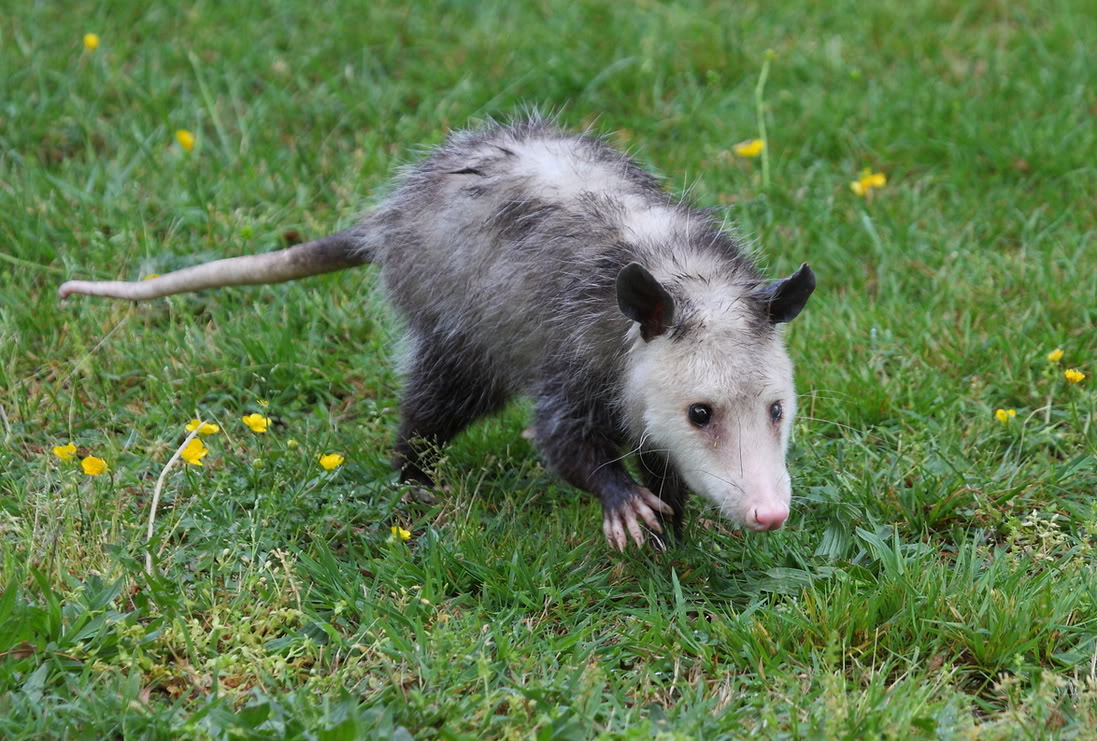
Squirrels are very active, especially in the morning and evening and are constantly moving during these times looking for food. They have excellent balance, rarely falling from trees and hurting themselves, they are also amazing swimmers.
The Eastern Gray Squirrels diet is varied and things such as acorns, hickory nuts, walnuts, apples, beechnuts, fungi, black cherry, grapes, insects, bird eggs and will also visit birdfeeders, dig up flower bulbs, and steal garden vegetables.
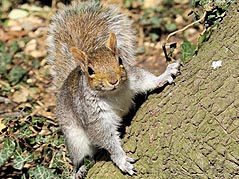
These are a sensitive birds that doesn't adjust well to changed environments are usually seen in small family groups or pairs and can live up to 20 years.
Sandhill cranes are omnivorous, eating a variety of plant and animal matter such as seeds, plant tubers, grains, berries, insects, earthworms, mice, snakes, lizards, frogs and crayfish but unlike other wading birds, sandhill cranes don't fish.
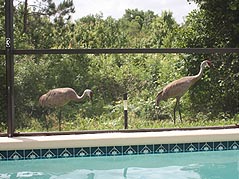
Red-shouldered hawks soar and circle with wings and tail spread out, and are often seen gliding underneath the forests canopy. However, unlike most hawks, the Red-shouldered Hawk hunts from a low-lying perch. This very fast and efficient bird of prey will sit quietly waiting for their prey to wander into their line of sight. Once spotted, the prey doesn't have a chance.
These forest hawks hunt a variety of prey including small mammals, birds, frogs, snakes, lizards, snails and insects.
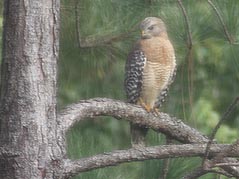
You may see a male picking up a seed, hop over to a female and watch them touch beaks as she takes the food, this is referred to as mate feeding.
Mate feeding continues through the egg-laying and incubation phases of breeding. The female will build the nest whilst the male keeps a close eye on her and the surrounding area for predators and other males.
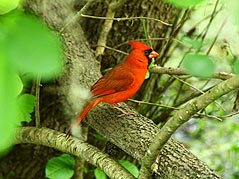
Seldom does this graceful and talented bird flap its wings as it takes advantage of rising thermals to keep it soaring over large areas searching for carrion or other scavengers at work. Unlike most other birds the Turkey Vulture uses its sense of smell as well as its eyesight to locate dead animals. It will often fly low to the ground to pick up the scent of decaying animals even finding them below a forest canopy.
The average adult bird weighs in at around 3 1/2 - 5 pounds, averages 2 foot long with a 6 foot wingspan and lives for around 16 years.
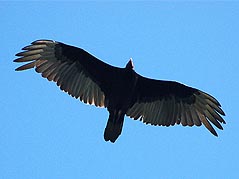
Mallards rarely dive so are often be seen completely upending in the water spending their time near the surface and dabbling for fish, amphibians, and a variety of plants. They also graze on land, feeding on grains, plants and whatever bread you have handy.
The average adult bird weighs in at around 3 pounds, averages 26 inches in length and live for up to 10 years.
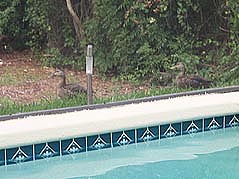
Box turtles have a highly domed upper shell with a bottom shell that's hinged so the shell can be completely shut to keep out predators. These characteristics contribute to this turtle's descriptive name. They reach maturity at 5 but continue growing for a further 20 years and have been known to live past 100 years.
The Box Turtle is omnivorous having a varied diet such as snails, insects, berries, fungi, slugs, worms, roots, flowers, fish, frogs, salamanders, snakes, birds, and eggs.
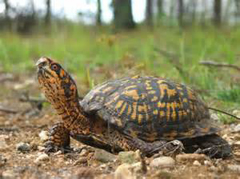
This is an aggressive predator, eating nearly anything that they can get their jaws around. Snappers are generally inoffensive when underwater, but when approached on land they will repeatedly try to bite. Their necks are quite long and they can snap and bite like lightning and even small snappers can inflict a painful wound with its hooked beak.
Snapping turtles can grow up to 18 inches long (excluding the tail) and 35 pounds in weight and can live for around 30 years.
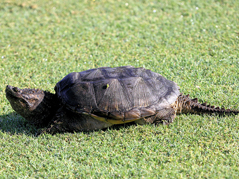
Green Anoles generally live in trees but can be found almost anywhere within suburban and urban areas. They are active by day in the warm weather and are often seen basking in vegetation, occasionally charging away rival anoles from their basking spot or to grab and inset. During the cooler weather anoles are often found hiding under tree bark, shingles, or in rotten logs.
Green Anoles eat a wide variety of insects, spiders, and other invertebrates are 5 to 8 inches long and lives for around 4 years.
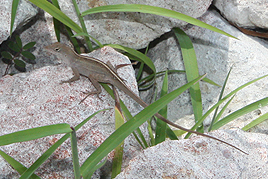
Racers prefer dry open fields, meadows and forest clearings and are active in the daylight hours. They are relatively easy to spot in the field as they often forage with their head and neck raised above their body. They often bask in the sun in low lying brush but can quickly disappear from view when disturbed. Racers are the only species that will occasionally charge at a person, this behavior is a bluff and the racer will retreat if challenged.
Racers eat a variety of rodents, insects, amphibians, other reptiles, birds, and bird eggs but despite their being classified as a constrictor, the Racer is more likely to suffocate or crush its victim into the ground rather than coiling around it in typical constrictor fashion.
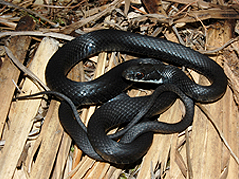
The Yellow rat snake is either a greenish, yellow, or an orange with four dark stripes running the length of the body. It's a powerful constrictor and is the best tree climber of all the Florida snakes.
The Gray rat snake is dark to light gray with darker gray or brown blotches and is found mostly in wooded areas around swamps. Juveniles of all subspecies resemble the gray rat snake.
Rat snakes are among the most valuable snakes found in Florida because of their skill in killing rats and mice.
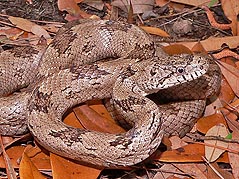
Stick Insects will generally mimic the colour of their surroundings being normally green or brown, although some species can be brilliantly colored whilst others are conspicuously striped.
Many stick insects have wings, some spectacularly beautiful, while others resemble little more than a stump.
Lifespan of around 3 years.
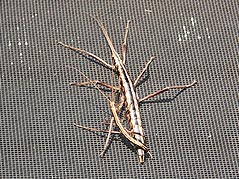
From the Giant Swallowtail to the Little Metalmark, the state has a wealth of flittering, fluttering, flappers, and gliders brightening the landscape.
Over 180 different butterflies have been recorded in Florida with 40 of those considered as being either unique to the state or occurring mostly within its boundaries.
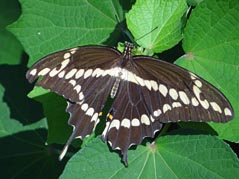
The light source these beetles emit comes from the abdomen area and happens when the beetle inhales oxygen. The oxygen then combines with a substance called luciferin in the abdomen with the reaction causing the flash.
The lights flash on and off for certain amounts of time determined by the sex of the firefly. The male emits a double flash every one to two meters and fly upward during the second flash, the female only emits a single flash between one and two seconds after the male finishes its second flash.
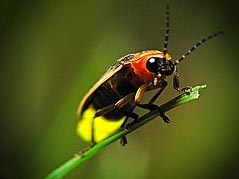
Once a nest is finished, she leaves it and never returns moving on to build more nests in other locations. The larvae hatch from the eggs and feed on the paralyzed spiders.
The complete development of the Mud Dauber takes place within the cell and in the spring the young adults come out of their nests and mate.
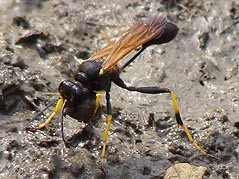
Whilst the Adult Love Bugs are harmless as the do not sting or bite, but they will take the paint off of a car if not quickly removed due to their slightly acidic body chemistry.
First, a mating swarm of males takes to the air followed by mating females and are quickly grasped by partners and whisked off to a more romantic setting in the vegetation. After mating, the pair remains entwined, and together they head off on a honeymoon of sorts, feeding on nectar and choosing a site to deposit the fertilized eggs.
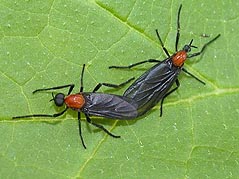
When an ant mound is disturbed, workers boil to the surface and run up any nearby legs or arms, they then grab the victim's skin in their mandibles and sting in response to the slightest movement. These attacks are coordinated and dozens or even hundreds of workers can sting in unison.
Approximately 95% of the venom from a Fire Ant sting is composed of alkaloids that are responsible for the pain and the white pustule that appears around a day after the sting occurred.
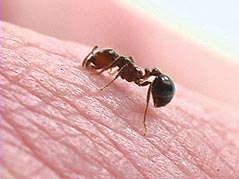
Outdoors, carpenter ants feed on both living and dead insects and are very attracted to honeydew, a sweet liquid produced by aphids and scale insects that feed on trees, shrubs, and other plants. Indoors the carpenter ant feeds on meats, as well as syrup, honey, sugar, jelly, and other sweets.
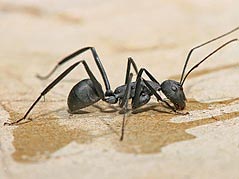
Providing an excellent service to humans is the Common Green Darner which is commonly known as "mosquito hawks" as they eat mosquitoes. Luckily for us, the Common Green Darner is the largest, most abundant and widespread dragonfly species in North America and they are commonly found around ponds, open bodies of fresh water and large blacktop parking lots.
When fully grown, Green Darners are around 3 inches long with a wingspan of 4.5 inches.
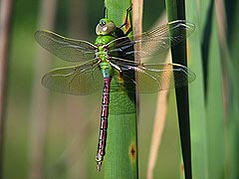
Outside, cockroaches are decomposers that feed on dead or dying plants and animals. However, when they interact with people they are considered pests, invading lawns and gardens or entering homes and other structures.
Whilst pest management is used it isn't infallible, further prevention methods include keeping the home free of food crumbs and storing perishables in sealed containers.
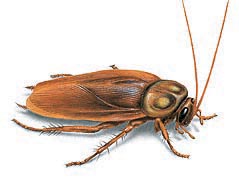
Darker individuals lack some of these markings so resemble black widows. In this case the best identifying characteristic is their egg-sac. The Brown widow egg-sacs are tan and spherical, with many small tufts of silk sticking out from them (like an old World War II harbor mine). The other widows make white, smooth egg sacs that tend to be pear-shaped.
Although the bite of a widow spider is much feared, the widow spiders are generally non-aggressive and will retreat when disturbed.
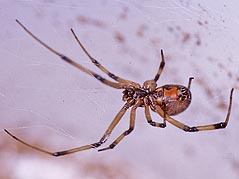
Males are black in colour with white fringes and range in size from 6mm to 12mm in length whilst the females have similar colour patterns except for black rear areas of their bodies covered in orange scales and range from 7mm to 22mm in length. Both have excellent vision.
Some observers manage to confuse jumping spiders with the poisonous black widow spider because of their similar colouring. You can tell the two spiders apart by noting that the black widows are shiny spiders that do not have hairy legs. Bites are much like a bee sting.
Once this spider realizes you don't intend to hurt it you can actually (with a lot of patience) hand feed them dead insects.
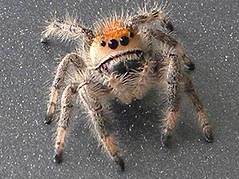
The dorsum of the abdomen is usually white with black spots and large red spines on the margin. The webs are the familiar flat, ornate, circular ones usually associated with spiders and typically contain tufts of silk, which may prevent birds from flying into them.
Females are 5 mm to 10 mm long and 10 mm to 14 mm wide and die after laying her eggs, the males die around 6 days after mating.
The famous spider from Charlotte's Web is a barn orb-weaver spider.
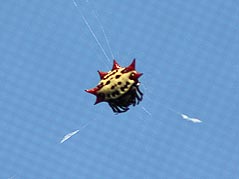
The female is distinctively colored, and is among the largest orb-weaving spiders in the country at 25 mm to 40 mm long. Males are only about 4-6 mm long are dark-brown in colour and are often found in the webs of females.
These spiders feed primarily on flying insects, which they catch in webs that can be more than a meter in diameter.
There is little real danger from the spider as it will only bite if it's held or pinched. The bite itself will only produce localized pain with a slight redness, which quickly goes away.
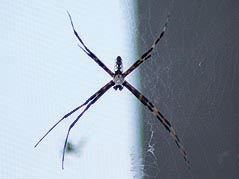


Linda & Robert using one of the following options:
Direct Enquiry: linda@dadsvilla.com
Or complete this: Enquiry Form
Telephone: +44 (0)1159 747120
Mobile: +44 (0)7894 907410
Home |
Villa Details |
Gallery |
Layout |
Rates & Dates |
Location |
FAQ |
Improvements |
Contact Us |
Local Info |
Terms
Disney Attractions |
Universal Attractions |
Alternate Attractions |
Formosa Gardens Village |
Rolling Oaks Commons
Shopping Malls |
Fishing |
Golf |
Crafting |
Beaches |
Weddings |
Driving |
Top Tips |
Local Wildlife |
Free To Do
Little Guests |
Size Chart |
Disney History |
Directions |
The Makeover |
Guest Book |
Villa Tips |
Site Map
Back to Top
© DadsVilla - 2009 - Designed by SpiderDaddy.com

